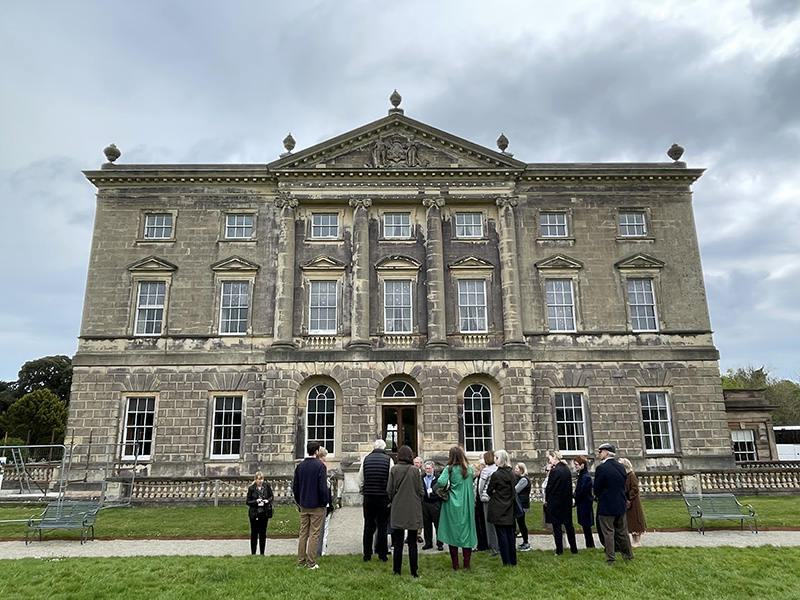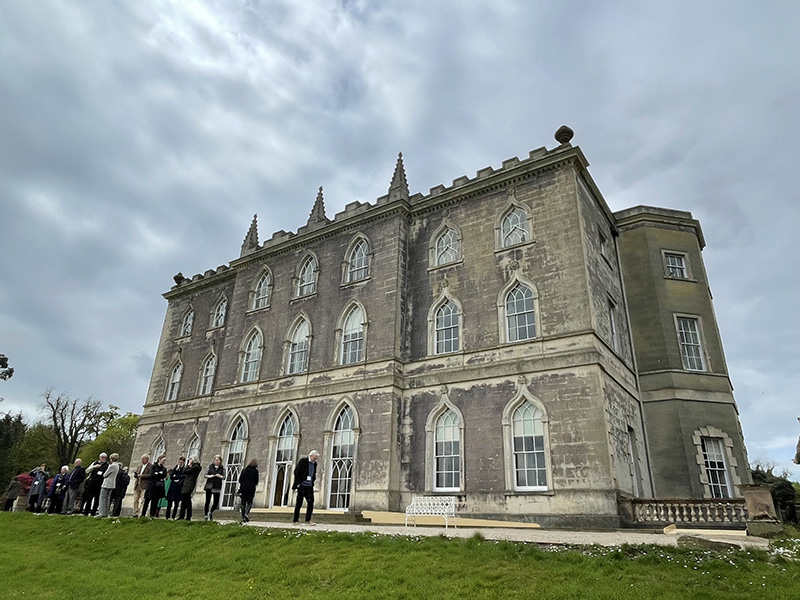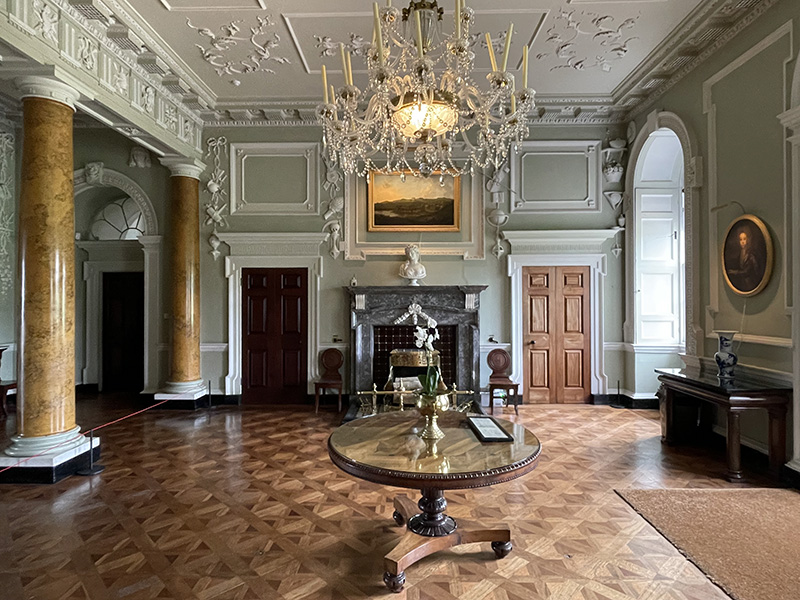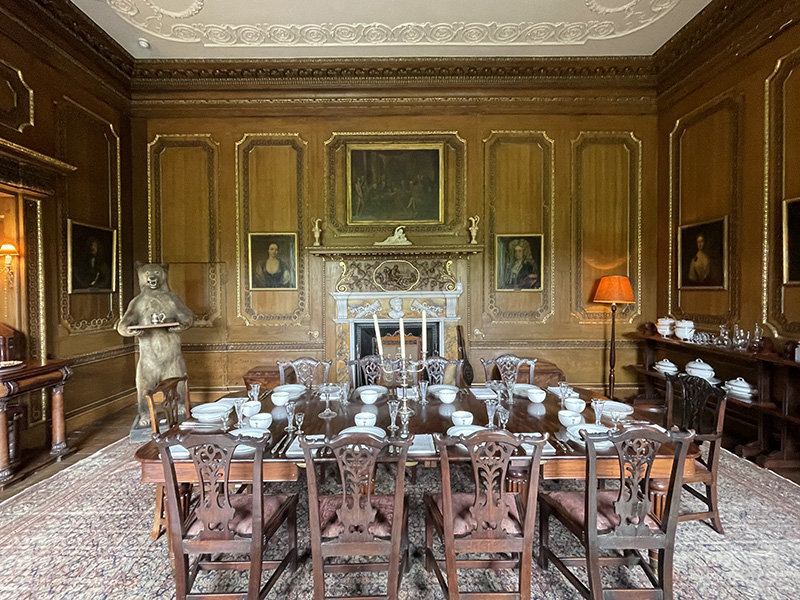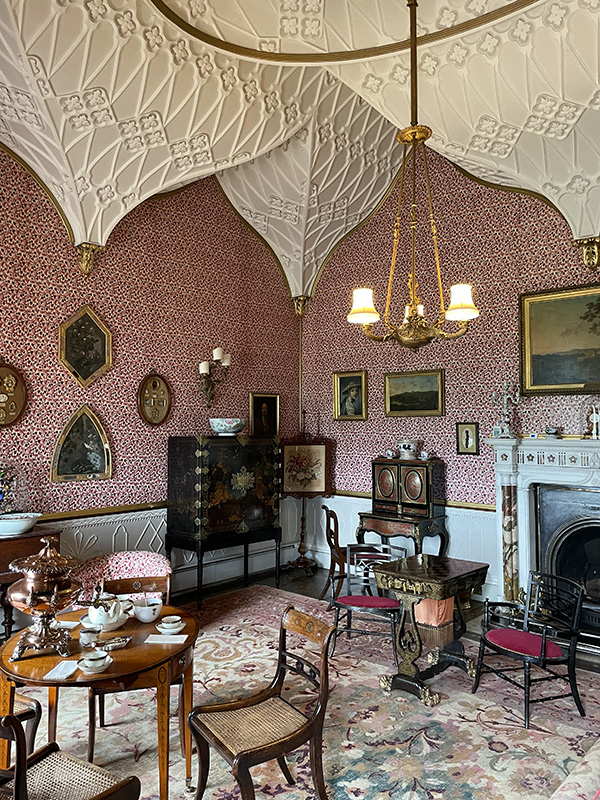An Intriguing Muddle in Northern Ireland
by Matthew A. Thurlow
“We are the people we have been waiting for.” This bold-yet-justified statement was delivered by Neil Watt, who serves as the resident collections manager of Castle Ward along with his partner Kris Reid. A National Trust property located in Northern Ireland’s County Down, the captivating country house benefited significantly from Neil and Kris’s dedicated and analytical stewardship throughout the pandemic lockdown, achieving international media attention in the process.
Castle Ward represents several common themes that the Trust encountered after bringing to fruition our twice-postponed Study Trip Abroad to Northern Ireland and the northern counties of the Republic of Ireland. Many of the great country houses we visited illustrate the layering of construction, renovation, and enhancement typical of multi-generational occupancy of the affluent Protestant aristocracy that dominated this region. Sustained wealth led to an 18th-century construction boom followed by 19th-century expansions and redesigns. Neil and Kris are attempting to reevaluate long-held assumptions about Castle Ward’s evolution and draw new interest to a relatively isolated property.
The house features an unusual amalgamation of architectural modes, with a front façade in the Palladian style, and a rear elevation in the Gothick taste popularized by Horace Walpole at Strawberry Hill starting in 1749 (figures 1 and 2). Architectural historians have long attributed this arrangement to the fractious marriage shared by Bernard Ward, Lord Bangor, and his wife, Lady Anne Magill, a widower. This union represented an advantageous tie of two prominent County Down families, but their acrimonious relationship resulted in a separation and Lady Anne’s subsequent relocation to Bath.
Castle Ward was built 1761–66 and is now attributed to the architect Robert Taylor, a student of William Chambers. Taylor helped the Wards replace an early-17th-century fortified house that was located on Strangford Loch at the base of the hill on top of which the present house stands. The earlier Ward home had been improved by Lord Bangor’s father in the early 1700s but was no longer sufficient for a family on the rise. Ward was swiftly moving up the peerage, eventually receiving the title of Viscount Bangor in 1781.
The contrasting façades were thought to serve as an early indication of the Ward’s inability to get along. Contemporary quotes provided support of this conclusion. A neighbor observed in 1763, “Mr. Ward is building a fine house… He wants taste and Lady Anne Ward is so whimsical that I doubt her judgment.”1 The interiors reflect the external disagreement with a range of Classical rooms (figure 3) at the front and a corresponding set of Gothick rooms at the rear. A splendid, if somewhat rustic, c. 1770 Gothick wardrobe suggests the continuation of this influence in the bed chambers above as well (figure 4). But might not this variety have resulted solely from the couple’s desire for a modish house that incorporated the two prevailing tastes of the day? This is the current, if less dramatic, argument for the bifurcation of Castle Ward.
A series of questions must be raised, however, regarding the origin of the spaces visitors encounter today. Our understanding is clouded by an 1830s revamp of Castle Ward under Lord Bangor’s grandson, Edward, who inherited the house following the 1827 death of his uncle Richard (who was declared a lunatic in 1785 and placed under disability by the Irish House of Lords for the remainder of his life). Edward, assuming the title of 3rd Viscount Bangor, appears to have put his own stamp on Castle Ward. Many of the present furnishings date from his occupancy, and he most likely refreshed some interiors as well.
The dining room, which sits to the left of the entry hall, sparked a spirited discussion about Edward’s influence on Castle Ward’s current appearance (figure 5). Reflecting on the cornice with a bolection molding, Trust Governor Ralph Harvard proposed that the paneling potentially predated the house by a half century and could have been transplanted by Edward from the family’s earlier house, at which time the ornamental plaster on the ceiling was also updated. A niche at the far end of the room was created to house a columnar sideboard Edward ordered for the room.
Further complicating matters is the campaign of renovations undertaken by renowned British designer John Fowler, whom the National Trust brought to Castle Ward in the 1960s to inject light and fresh surfaces into what had become dark Victorian rooms. In the entrance hall, Fowler introduced a chandelier far too late for the 1760s interior and paint colors that are perhaps deserving of a careful analysis to determine the original scheme. In the Gothick drawing room, initially decorated by Bernard and Anne with a Chinoiserie theme, Fowler installed a rich floral wallpaper that belies the aesthetic intent of the space (figure 6).
Neil and Kris’s focus during the pandemic lockdown was on bringing the interiors back to a semblance of their appearance in the late 18th and early 19th centuries and considering the interpretive opportunities presented by Castle Ward’s history. An essential first step was mitigating the damp that has long plagued the house with a new dehumidifying system that sparked an intensive period of cleaning and polishing. Among a variety of improvements to the furnishing plan, they replaced the overstuffed parlor furniture that visitors previously encountered in the front hall with Edward’s 1830s hall chairs (figure 3). Neil and Kris also see the chance for the National Trust to discuss a variety of important topics with visitors, including the treatment of mental illness in the late 18th and early 19th centuries and Lady Anne’s role as a well-traveled and independent force behind the house’s development.
As with all historic houses, the ambitious plans for Castle Ward will only be curtailed by time and resources. As funding allows, Neil and Kris intend to continue to inject new life into this fascinating house.
- Quoted in Girouard, Mark. “Castleward, County Down—I,” Country Life, November 23, 1961, p. 1262.
Matthew A. Thurlow is the Executive Director of the Decorative Arts Trust.
A print version of this article was published in The Magazine of the Decorative Arts Trust, one of our most popular member benefits. Join today!

